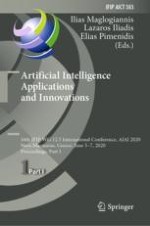This 2 volume-set of IFIP AICT 583 and 584 constitutes the refereed proceedings of the 16th IFIP WG 12.5 International Conference on Artificial Intelligence Applications and Innovations, AIAI 2020, held in Neos Marmaras, Greece, in June 2020.*
The 70 full papers and 5 short papers presented were carefully reviewed and selected from 149 submissions. They cover a broad range of topics related to technical, legal, and ethical aspects of artificial intelligence systems and their applications and are organized in the following sections:
Part I: classification; clustering - unsupervised learning -analytics; image processing; learning algorithms; neural network modeling; object tracking - object detection systems; ontologies - AI; and sentiment analysis - recommender systems.
Part II: AI ethics - law; AI constraints; deep learning - LSTM; fuzzy algebra - fuzzy systems; machine learning; medical - health systems; and natural language.
*The conference was held virtually due to the COVID-19 pandemic.
